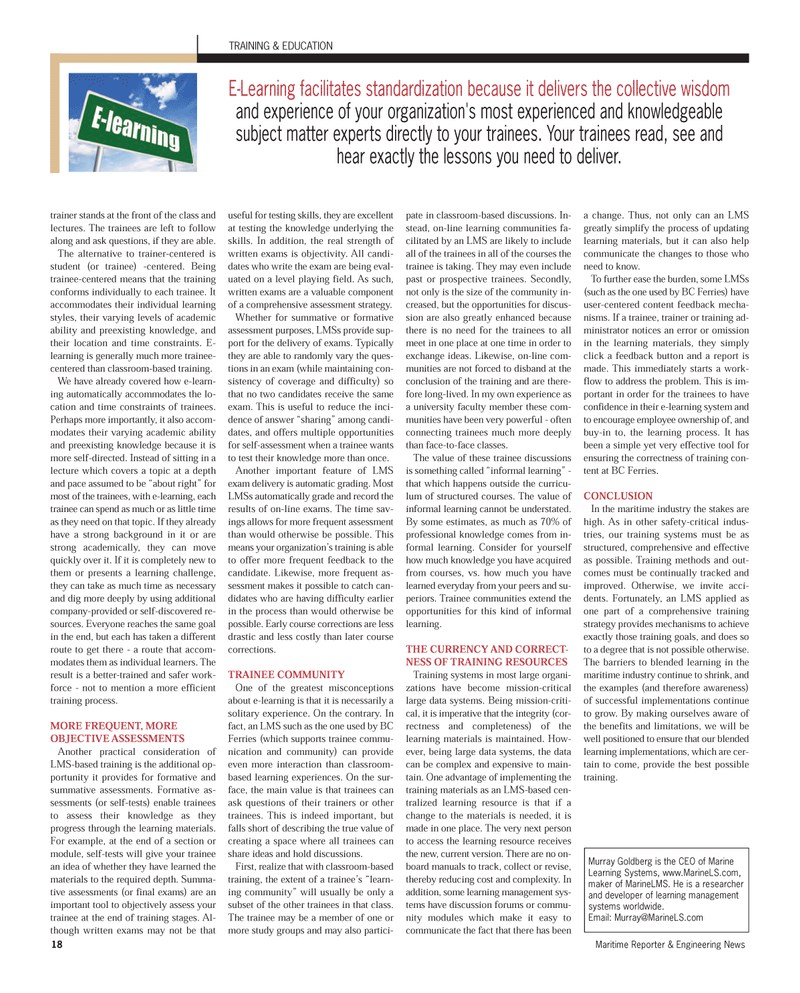
Page 18: of Maritime Reporter Magazine (June 2012)
Annual World Yearbook
Read this page in Pdf, Flash or Html5 edition of June 2012 Maritime Reporter Magazine
trainer stands at the front of the class andlectures. The trainees are left to follow along and ask questions, if they are able. The alternative to trainer-centered is student (or trainee) -centered. Beingtrainee-centered means that the trainingconforms individually to each trainee. It accommodates their individual learning styles, their varying levels of academic ability and preexisting knowledge, and their location and time constraints. E-learning is generally much more trainee-centered than classroom-based training.We have already covered how e-learn- ing automatically accommodates the lo-cation and time constraints of trainees.Perhaps more importantly, it also accom- modates their varying academic ability and preexisting knowledge because it is more self-directed. Instead of sitting in alecture which covers a topic at a depth and pace assumed to be ?about right? formost of the trainees, with e-learning, eachtrainee can spend as much or as little timeas they need on that topic. If they already have a strong background in it or are strong academically, they can move quickly over it. If it is completely new to them or presents a learning challenge,they can take as much time as necessary and dig more deeply by using additionalcompany-provided or self-discovered re- sources. Everyone reaches the same goal in the end, but each has taken a different route to get there - a route that accom-modates them as individual learners. The result is a better-trained and safer work- force - not to mention a more efficient training process.MORE FREQUENT, MORE OBJECTIVE ASSESSMENTSAnother practical consideration ofLMS-based training is the additional op-portunity it provides for formative and summative assessments. Formative as- sessments (or self-tests) enable traineesto assess their knowledge as they progress through the learning materials.For example, at the end of a section or module, self-tests will give your trainee an idea of whether they have learned the materials to the required depth. Summa-tive assessments (or final exams) are an important tool to objectively assess your trainee at the end of training stages. Al- though written exams may not be that useful for testing skills, they are excellent at testing the knowledge underlying the skills. In addition, the real strength ofwritten exams is objectivity. All candi- dates who write the exam are being eval- uated on a level playing field. As such, written exams are a valuable component of a comprehensive assessment strategy. Whether for summative or formative assessment purposes, LMSs provide sup- port for the delivery of exams. Typically they are able to randomly vary the ques- tions in an exam (while maintaining con- sistency of coverage and difficulty) so that no two candidates receive the same exam. This is useful to reduce the inci- dence of answer ?sharing? among candi-dates, and offers multiple opportunities for self-assessment when a trainee wants to test their knowledge more than once. Another important feature of LMSexam delivery is automatic grading. Most LMSs automatically grade and record theresults of on-line exams. The time sav- ings allows for more frequent assessment than would otherwise be possible. This means your organization?s training is able to offer more frequent feedback to the candidate. Likewise, more frequent as- sessment makes it possible to catch can- didates who are having difficulty earlier in the process than would otherwise be possible. Early course corrections are lessdrastic and less costly than later coursecorrections.TRAINEE COMMUNITYOne of the greatest misconceptionsabout e-learning is that it is necessarily asolitary experience. On the contrary. In fact, an LMS such as the one used by BC Ferries (which supports trainee commu-nication and community) can provide even more interaction than classroom- based learning experiences. On the sur- face, the main value is that trainees can ask questions of their trainers or othertrainees. This is indeed important, but falls short of describing the true value of creating a space where all trainees canshare ideas and hold discussions.First, realize that with classroom-basedtraining, the extent of a trainee?s ?learn- ing community? will usually be only asubset of the other trainees in that class.The trainee may be a member of one ormore study groups and may also partici- pate in classroom-based discussions. In-stead, on-line learning communities fa- cilitated by an LMS are likely to include all of the trainees in all of the courses thetrainee is taking. They may even include past or prospective trainees. Secondly, not only is the size of the community in-creased, but the opportunities for discus- sion are also greatly enhanced becausethere is no need for the trainees to allmeet in one place at one time in order toexchange ideas. Likewise, on-line com- munities are not forced to disband at theconclusion of the training and are there-fore long-lived. In my own experience as a university faculty member these com- munities have been very powerful - often connecting trainees much more deeplythan face-to-face classes. The value of these trainee discussions is something called ?informal learning? -that which happens outside the curricu- lum of structured courses. The value of informal learning cannot be understated.By some estimates, as much as 70% ofprofessional knowledge comes from in- formal learning. Consider for yourselfhow much knowledge you have acquired from courses, vs. how much you have learned everyday from your peers and su- periors. Trainee communities extend the opportunities for this kind of informallearning.THE CURRENCY AND CORRECT- NESS OF TRAINING RESOURCES Training systems in most large organi- zations have become mission-critical large data systems. Being mission-criti- cal, it is imperative that the integrity (cor- rectness and completeness) of thelearning materials is maintained. How- ever, being large data systems, the data can be complex and expensive to main- tain. One advantage of implementing the training materials as an LMS-based cen-tralized learning resource is that if achange to the materials is needed, it ismade in one place. The very next person to access the learning resource receives the new, current version. There are no on- board manuals to track, collect or revise, thereby reducing cost and complexity. In addition, some learning management sys-tems have discussion forums or commu- nity modules which make it easy to communicate the fact that there has been a change. Thus, not only can an LMS greatly simplify the process of updatinglearning materials, but it can also help communicate the changes to those whoneed to know. To further ease the burden, some LMSs (such as the one used by BC Ferries) have user-centered content feedback mecha- nisms. If a trainee, trainer or training ad-ministrator notices an error or omissionin the learning materials, they simply click a feedback button and a report is made. This immediately starts a work- flow to address the problem. This is im- portant in order for the trainees to have confidence in their e-learning system and to encourage employee ownership of, and buy-in to, the learning process. It has been a simple yet very effective tool for ensuring the correctness of training con-tent at BC Ferries. CONCLUSIONIn the maritime industry the stakes are high. As in other safety-critical indus- tries, our training systems must be asstructured, comprehensive and effective as possible. Training methods and out- comes must be continually tracked and improved. Otherwise, we invite acci- dents. Fortunately, an LMS applied as one part of a comprehensive training strategy provides mechanisms to achieve exactly those training goals, and does so to a degree that is not possible otherwise. The barriers to blended learning in themaritime industry continue to shrink, andthe examples (and therefore awareness) of successful implementations continueto grow. By making ourselves aware of the benefits and limitations, we will be well positioned to ensure that our blendedlearning implementations, which are cer- tain to come, provide the best possible training.18Maritime Reporter & Engineering News TRAINING & EDUCATION Murray Goldberg is the CEO of Marine Learning Systems, www.MarineLS.com, maker of MarineLMS. He is a researcher and developer of learning managementsystems worldwide. Email: [email protected] facilitates standardization because it delivers the collective wisdom and experience of your organization's most experienced and knowledgeable subject matter experts directly to your trainees. Your trainees read, see and hear exactly the lessons you need to deliver. MR June12 # 3 (17-24):MR Template 6/11/2012 9:23 AM Page 18

 17
17

 19
19
